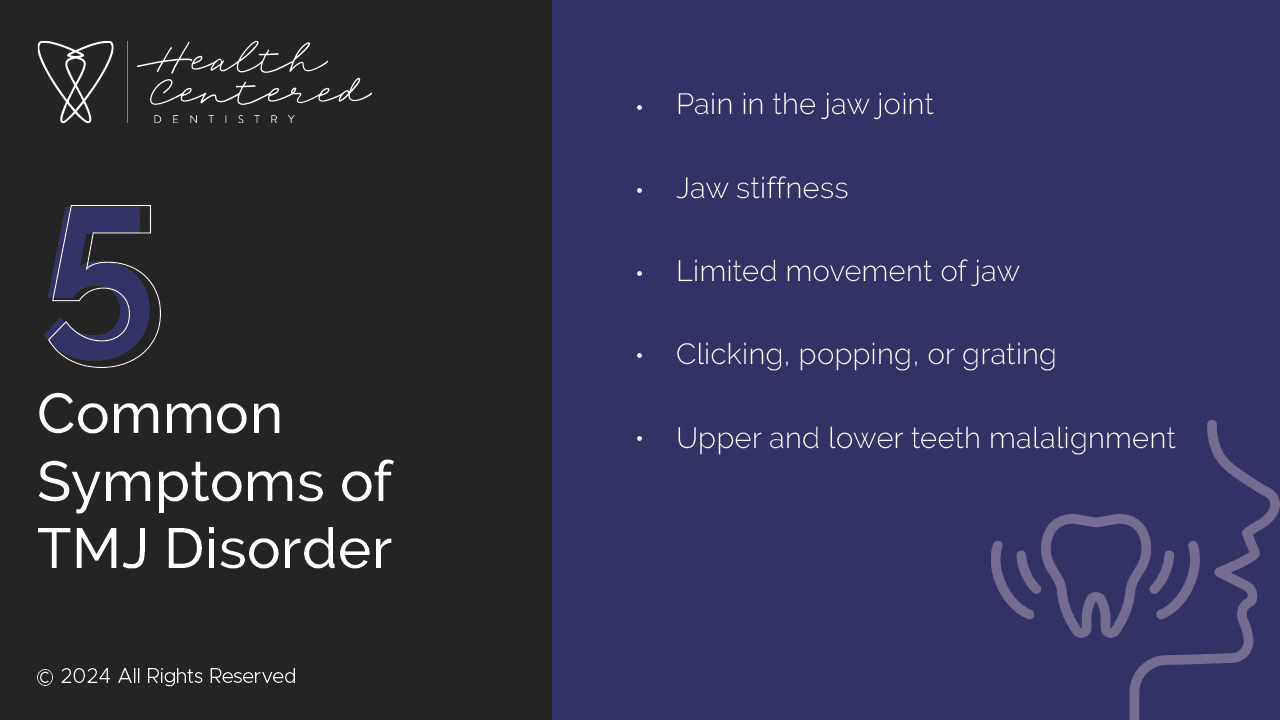Do you suffer from jaw pain? This could be caused by a TMJ disorder. TMJ disorders are often not serious and can be treated holistically with minimally invasive treatments and habits. This brief but comprehensive guide will help you understand TMJ disorders, symptoms, causes, and treatments.
If you are experiencing chronic jaw pain, contact Health Centered Dentistry for an appointment for an evaluation.
What are TMJ disorders?
To understand TMJ disorders, one must first understand what TMJ is and what it does. The temporomandibular joint (TMJ) is a sliding hinge that connects the jaw to the skull. With TMJ disorders, this jaw joint is affected, causing pain in the jaw muscles that control jaw movement.
Diagnosis of a temporomandibular disorder is difficult. The exact causes and symptoms of temporomandibular joint dysfunction vary so greatly that sometimes other issues need to be ruled out before a TMJ disorder is diagnosed. Essentially, your dentist will take a detailed medical history, examine jaw joints and movements, and may order tests such as X-rays, magnetic resonance imaging (MRI), or computed tomography (CT).
TMJ Symptoms

The symptoms of temporomandibular disorders can vary, and some of the symptoms may not seem related to the jaw at all. Here at HCD, your dentist will ask many questions about your symptoms when diagnosing TMJ disorders.
Some TMJ symptoms may include:
- pain in the jaw joints with jaw movement
- facial pain or neck aches
- jaw stiffness
- limited movement of the jaw joint or jaw-locking
- painful clicking, popping, or grating of the jaw joint when opening or closing the mouth
- ringing in the ears, hearing loss, or dizziness
- a change in the way the upper and lower teeth fit together
You may have some or all of these symptoms with temporomandibular disorders. Many people are surprised to learn that the jaw joints can affect the ears. TMJ pain can vary with these disorders and may be quite severe. Severe symptoms should be addressed with a doctor or dentist as soon as possible.
Causes of TMJ Disorders
The exact cause of TMJ disorders is often unknown. There are a variety of factors that can contribute to one developing a TMJ disorder. Teeth grinding or clenching the teeth can lead to temporomandibular joint problems. This is because the temporomandibular joints are under pressure. However, many people grind their teeth without ever developing TMJ disorders.
Arthritis may also contribute to a TMJ disorder. If a temporomandibular joint is affected by arthritis, it could cause pain in the jaw muscles. A jaw injury can be another factor that leads to temporomandibular joint syndrome. However, not everyone who suffers a jaw injury will develop a TMJ disorder. According to the National Institute of Dental and Craniofacial Research, recent studies suggest that genes may play a factor in whether or not someone develops a disorder in the temporomandibular joint TMJ.
Treatments for TMJ Disorder
The treatments your doctor or dentist is likely to recommend may depend on the cause of the TMJ disorder. A treatment plan could consist of changing or breaking habits, pain management, physical therapy, or a variety of other nonsurgical treatments.
Changing or Breaking Habits
There are a lot of things you can do on your own to limit the jaw pain that comes with TMJ disorders and allow the jaw joint to heal. Eat soft foods that don’t require chewing muscles as a way to limit jaw pain. Chewing gum can exacerbate the problem or make symptoms worse, so avoid chewing gum.
If your temporomandibular disorder is caused by teeth grinding, you will need to break this habit in order to allow the temporomandibular joint to heal. There are a variety of behavioral health approaches that can be used to help you break this habit, such as mindfulness techniques, relaxation techniques, biofeedback, and cognitive behavioral therapy.
In biofeedback, a sensor on the jaw can detect when you tighten your jaw muscles so that you can identify these moments and learn to relax. Cognitive behavioral therapy focuses on learning to identify negative thoughts and habits and changing them. Life stressors can lead to teeth grinding, and a therapist may be able to teach you better coping skills.
Holistic Treatments
While conventional treatments often focus on pain relief, many people are turning to holistic approaches to find a more comprehensive path to healing. Holistic dental treatments for TMJ address not only the symptoms but also the underlying factors contributing to jaw discomfort, helping patients achieve long-lasting relief and improved quality of life.
1. Chiropractic Care
Chiropractic adjustments can help realign the spine and jaw, reducing tension and pressure in the TMJ area. By addressing the alignment of the jaw, neck, and spine, chiropractic treatments can relieve muscle strain and improve overall posture, which may reduce TMJ symptoms over time.
2. Acupuncture
Acupuncture targets specific points in the body to alleviate pain and tension. For TMJ, acupuncture can help reduce jaw pain, relax the surrounding muscles, and release endorphins, the body’s natural painkillers. Regular sessions may promote long-term relief by decreasing inflammation and promoting energy flow around the joint.
3. Myofascial Release Therapy
Myofascial release involves gentle, hands-on techniques that reduce tension in the fascia (the connective tissue surrounding muscles) in the jaw, neck, and face. By relieving restrictions in these areas, myofascial release can improve mobility, ease discomfort, and support natural alignment, helping alleviate TMJ-related pain.
4. Craniosacral Therapy
This light-touch therapy works on the craniosacral system to release tension and improve fluid circulation, which can enhance the body’s ability to self-heal. For TMJ, craniosacral therapy can be particularly beneficial in relieving muscle and joint restrictions, reducing jaw pressure, and restoring balance to the nervous system.
5. Herbal and Nutritional Support
Holistic dentists may recommend anti-inflammatory herbs and a diet rich in magnesium, calcium, and vitamin D to support joint health. Supplements like turmeric, ginger, and omega-3 fatty acids can help decrease inflammation, while magnesium relaxes muscles, potentially reducing TMJ symptoms over time.
Dental Appliances and Treatments
Mouth guards are a great way to limit teeth grinding and clenching. Mouth guards should be ordered by a dentist, who will ensure that they fit your mouth appropriately. Oral splints can also be used to relieve pressure from the temporomandibular joints. Oral splints are also custom-made to fit your mouth comfortably.
Health Centered Dentistry provides mouthguards to patients on a frequent basis. Part of our family dentistry services includes custom fitting a mouth guard.
Nonsurgical Treatments
Physical therapy may improve TMD pain and improve movement. Your doctor or dentist will give you jaw exercises to do to strengthen the jaw muscles and the jaw joints. Some exercises are designed to gently stretch the jaw to relieve pain.
Another nonsurgical treatment is Transcutaneous Electrical Nerve Stimulation (TENS). Electrodes are strategically placed along the jaw line and small electrical impulses are projected into the jaw muscles. This can relax the jaw muscles and jaw joint to relieve pain. A TENS unit may be used by your doctor or dentist, or you can get home units to use at your convenience.
Other Treatments
There are a variety of other treatments for a TMJ disorder that are not proven to be beneficial and should be avoided. These include occlusal treatments designed to change the teeth or bite, as well as the use of Botox to relax the jaw muscles. If a dentist suggests these treatments, ensure that they are entirely necessary.
When the temporomandibular joint is out of place, your doctor or dentist might suggest arthrocentesis. In this procedure, a needle is inserted and liquid is pushed into the temporomandibular joint. The pressure from the liquid removes adhesions while flushing the fluid out of the joint removes debris that can cause inflammation.
TMJ arthroscopy is another treatment and diagnostic tool. The arthroscopy allows the doctor or dentist to see the joint. This can help them put the joint back in place or remove adhesions. The procedure can also be used to diagnose TMJ disorders.
Surgery is a last resort when it comes to temporomandibular disorders. Open joint surgery results in permanent changes to the jaw joint, and should not be taken lightly. Surgery may be required if there is damage to the temporomandibular joint that cannot be corrected any other way. It is also sometimes used when symptoms are severe with pain and difficulty opening the mouth and other treatments have failed.
Treatment for TMJ Disorders at Health Centered Dentistry in Anchorage
If you have jaw pain that might be related to a TMJ disorder, Health Centered Dentistry in Anchorage is here for you. We are familiar with the best treatments for TMJ disorders, including physical therapy, dental appliances, and TMJ arthroscopy.
Contact us today to schedule your appointment!


